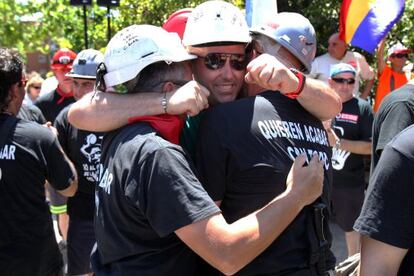Miners’ black march arrives at gates of Madrid after 400km odyssey
Mass rally planned outside Industry Ministry Wednesday to protest subsidy cuts

The countdown has begun. On Monday the so-called “black march” of miners descended on the outskirts of the capital after a grueling advance of some 430 kilometers, often in searing heat. The northern column, which set out from Asturias, Palencia and León over two weeks ago, reached the suburb of Aravaca on Monday afternoon, where they were greeted by applause and cheers of support from residents.
“Long live the working class struggle,” cried one elderly local. “We’re going to bring Madrid to a standstill,” replied a euphoric miner, moved by the reception the protestors have received. Earlier in the day, while marching through Villalba, some 3,000 people poured onto the streets to greet the column.
The Aragon column, which started out from Zaragoza and Teruel, reached the satellite town of Alcobendas north of Madrid, where it was joined by labor union representatives for a rally in the main square before retiring to a nearby municipal sports center to patch up their weary bodies and rest.
Both columns are due to march in Madrid on Tuesday night in full mining gear, with their helmet lights and lamps ablaze, to protest proposed cuts to mining subsidies of 63 percent, which would effectively kill the sector in Spain. On Wednesday a march is planned from the Colón square to the Industry Ministry. Organizers hope some 25,000 people will turn out.
“We want it to be as striking as possible so that everybody who wishes to unite with us can do so,” said the secretary general of the SOMA-UGT Asturian mining union, José Luis Alperi. “All we ask is that the government honor what they agreed and that they meet with us to negotiate. With a 63-percent cut, a lot of people are going to join the unemployment lines.”
We don’t understand how there is money to bail out the banks but not the mining sector”
At the sports center in Aravaca, Arturo, a miner from Fabero, Bierzo-León, went straight to the infirmary to have a troublesome toenail removed.
“It’s no big deal,” he stoically observed. “Others have had much worse and have had to go home. What we don’t understand is how the government has money to bail out the banks that caused the crisis but won’t support the mining sector.” More than 300,000 people will be affected by the subsidy cuts, added Arturo.
Two miners also on the march pointed out that the sector still serves to put young men in mining regions into work, in a country where half of people between 18 and 24 are unemployed. “We work together in Carrio [mine] and we are friends,” says Daniel Robledo. “We are to defend what is ours. We are both 24, so if we don’t do it, who will? Only by sticking together can we get through this, and a lot of people don’t have the fortune to be able to stand up for their rights.”
On Wednesday, Prime Minister Mariano Rajoy is due in Congress to hear the arguments of opposition parties on the proposed subsidy reduction. The central government delegate in Madrid, Cristina Cifuentes, said that a “sufficient and adequate” police presence will be in place to ensure the safety of citizens during the protest, although Cifuentes was at pains to stress that the march had been entirely peaceful.
Tu suscripción se está usando en otro dispositivo
¿Quieres añadir otro usuario a tu suscripción?
Si continúas leyendo en este dispositivo, no se podrá leer en el otro.
FlechaTu suscripción se está usando en otro dispositivo y solo puedes acceder a EL PAÍS desde un dispositivo a la vez.
Si quieres compartir tu cuenta, cambia tu suscripción a la modalidad Premium, así podrás añadir otro usuario. Cada uno accederá con su propia cuenta de email, lo que os permitirá personalizar vuestra experiencia en EL PAÍS.
¿Tienes una suscripción de empresa? Accede aquí para contratar más cuentas.
En el caso de no saber quién está usando tu cuenta, te recomendamos cambiar tu contraseña aquí.
Si decides continuar compartiendo tu cuenta, este mensaje se mostrará en tu dispositivo y en el de la otra persona que está usando tu cuenta de forma indefinida, afectando a tu experiencia de lectura. Puedes consultar aquí los términos y condiciones de la suscripción digital.








































